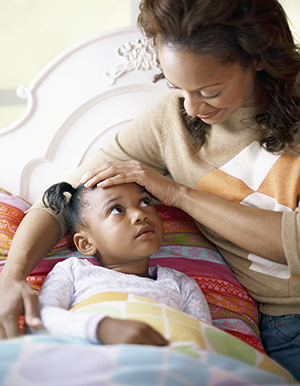Treating Viral Respiratory Illness in Children
Viral respiratory illnesses include colds, the flu, and RSV (respiratory syncytial virus). Treatment focuses on relieving your child’s symptoms and ensuring that the infection doesn't get worse. Antibiotics are not effective against viruses. Antiviral medicines may be used for the flu in some cases. Always see your child’s healthcare provider if your child has trouble breathing.

Helping your child feel better
-
Give your child plenty of fluids, such as water or apple juice.
-
Make sure your child gets plenty of rest.
-
Keep your infant’s nose clear. Use a rubber bulb suction device to remove mucus as needed. Don't be aggressive when suctioning. This may cause more swelling and discomfort.
-
Raise the head of your child's bed slightly to make breathing easier.
-
Run a cool-mist humidifier or vaporizer in your child’s room to keep the air moist and nasal passages clear.
-
Don't let anyone smoke near your child.
-
Treat your child’s fever with acetaminophen. In infants 6 months or older, you may use ibuprofen instead to help reduce the fever. Never give aspirin to a child under age 18. It could cause a rare but serious condition called Reye syndrome.
When to seek medical care
Most children get over colds and flu on their own in time, with rest and care from you. Call your child's healthcare provider or seek medical care right away if your child:
-
Has a fever of 100.4°F (38°C) in a baby younger than 3 months
-
Has a repeated fever of 104°F (40°C) or higher
-
Has nausea or vomiting, or can’t keep even small amounts of liquid down
-
Hasn’t urinated for 6 hours or more, or has dark or strong-smelling urine
-
Has a harsh cough, a cough that doesn't get better, wheezing, or trouble breathing
-
Has flaring of the nostrils while breathing
-
Has retractions, which is when the skin pulls in between the ribs, with breathing
-
Has bad or increasing pain
-
Develops a skin rash
-
Is very tired or lethargic
-
Develops a blue color to the skin around the lips or on the fingers or toes